
Transport in flowering plants

Transport on flowering plants
Water and mineral salts are transported xylem while the manufactured food is transported in the phloem
Xylem
Consist of parenchyma cells and fibers together with vessels and tracheid.

Vessels are made of cylindrical dead cells, one on top of another with the cross wall broken down to form a long continuous tube from the roots to the leaves.
The type of vessel found to depend on the degree and nature of cell thickening. In the protoxylem the lignin is deposited in rings or spirals to the cells is still capable of expansion. In metaxylem, there is more extensive lignification arranged in patterns known as reticulate, scalariform or pitted.
Types of cell wall thickening are given below
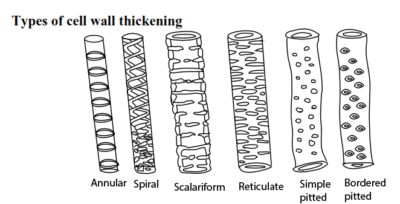
Tracheid are spindle-shaped cell arranged in rows with ends of the cells overlapping. The cells have heavily lignified cell wall with no cell contents.
Functions of xylem
1. Transport water and mineral salts
2. They provide mechanical support.
Adaptations of the xylem
1. Cross walls are perforated or completely removed to form continuous tubes from roots to stems and leaves
2. Xylem vessels have no living contents to allow water to flow freely
3. Contain bordered pits to allow water cross to living cells
4. Lignified to prevent water loss
5. Lignified to prevent them from collapsing under negative pressure of transpiration pull.
6. Small tube to enable high capillarity
7. Xylem walls have high adhesive forces.
8. Torus in bordered pits act as a plug for controlling passage of water in some plants
Adaptation of xylem to provide support
1. Walls are lignified
2. Vessels are circular for additional support.
Development of xylem
Cells destined to form xylem vessel elongate and develop thickened secondary wall. The walls are later lignified. The cell content die and cross-section walls degenerate to form continuous open tube.

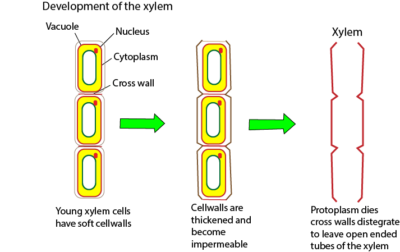
Phloem
The phloem consists of sieve tubes and companion cells.
Sieve tubes consist of columns of elongated, thin-walled living cells called sieve tubes/elements. They have cross walls with many holes or pores called sieve plates. Each sieve tube has a companion cell.
Functions of phloem
Transport of manufactured food (sucrose and amino acid) from leaves to other parts of the plant.
Sucrose is the choice of food transport probably because
1. it is soluble in water unlike starch
2. less reactive than glucose
3. has high energy content than glucose
Adaptations phloem for its functions
1. Lack of a nucleus and most cell organelles to leave room for transportation of food
2. The sieve plates are perforated to allow rapid flow through from one cell to another.
3. Has filament for quick transport by streaming
4. An intimate association with companion cells to obtain energy and materials
Differences between xylem and phloem
| Xylem | Phloem | |
| 1 | Vessels are made of dead cells | Elements are made from living cells |
| 2 | Vessels have lignified cell walls | Phloem do not have lignified cell walls |
| 3. | The end wall disappears completely | The end wall form sieve plates. They do not disappear completely |
| 4. | Have pits | Have plasmodesmata |
| 5. | Thick walls | Thin walls |
| 6 | Transport water and mineral salts | Transport food (sucrose and amino acids) |
Development of phloem
Cells destined to become sieve elements elongate, most cell organelles degenerate leaving cytoplasmic filament. The plasmodesmata of the end wall widen forming sieve pores.
Absorption of water by roots
Water is absorbed by root hair by osmosis whereas mineral salts are absorbed by active transport.
Adaptations of root hair for the absorption of water
1. They are numerous to provide large surface area
2. They have thin epithelium to reduce the diffusion distance
3. Have vacuole with salt to facilitate osmosis
Absorption of mineral salts
By active transport when the concentration of the mineral is lower in the soil. Minerals cannot be passively absorbed by roots. There are two main reasons for this.
(i) Minerals are present as charged particles in the soil. They cannot move across cell membranes.
(ii) The concentration of minerals in the soil is usually lower than the concentration of minerals in the root since they are usually in low concentration and charged.
Sections through a dicotyledonous root and monocotyledonous
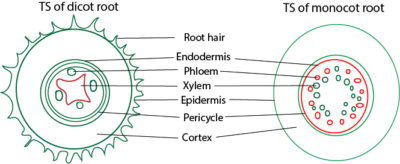

Functions of parts of the root
Root hair – absorb water and mineral salts
Xylem – transport water from root to other parts of the body
Phloem – transport food to all parts of the
Cortex – is made up of parenchyma cells for support and storage
Pericycle – become lignified in older roots to provide support and is where lateral roots develop
Special methods of obtaining nutrients by plants
- Some plants have mycorrhiza, an association of root and fungi; the fungi decompose humus into soluble nutrients (nitrogen and phosphorus) and also increases the surface area for their absorption by the roots. Plants that lack chlorophyll also obtain, carbohydrates and proteins from the fungi.
- Legumes such as peas, beans, and soya bean have nitrogen-fixing bacteria in their root nodules for fixation of nitrogen.
- Plants in nitrogen-deficient are feed on insects to obtain nitrogen.
Differences between dicotyledonous and monocotyledonous root
| Properties | Dicot Root | Monocot Root |
| Pericycle | Gives rise to cork cambium, parts of the vascular cambium, and lateral roots | Gives rise to lateral roots only |
| Vascular Tissues | Has a limited number of Xylem and Phloem | Has a higher number of Xylem and Phloem |
| Shape of Xylem | Angular or Polygonal | Round or Oval |
| Number of Xylem and Phloem | 2 to 8 | 8 to many |
| Pith | Absent or very small and undeveloped | Larger and well developed |
| Conjunctive tissue | Parenchymatous | Sclerenchymatous |
| Secondary growth | Secondary growth occurs | Secondary growth does not occur |
| Cambium | Present and formed by the Conjunctive parenchyma | Absent |
| Xylem | Usually tetrarch | Polyarch |
| Cortex | Comparatively Narrow | Very wide |
| Covering | Older roots are covered by a Cork | Older roots are covered by an Exodermis |
| Examples | Pea, beans, peanuts, etc. | Maize, banana, palm, etc. |
The route taken by water from roots to stem
1. The apoplast pathway: this consists of the interconnected cell walls of adjacent cell which are in contact with each other and therefore form continuous system. The water flows in the spaces between the cellulose microfibrils.
2. The Symplast pathway: this consist of the cytoplasm which is continuous from cell to cell via the plasmodesmata. To get into the Symplast pathway water has to cross the partially permeable plasma membrane by osmosis.
3. The vacuolar pathways through the vacuoles.
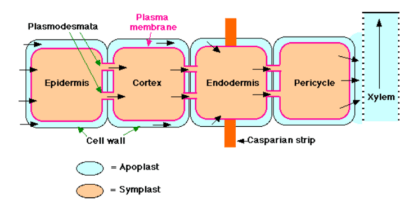
Both pathways are used, but most water follow the apoplast pathways as this is the fasted of the two. Once the water reaches the endoderm, water is diverted from apoplast pathway to Symplast pathway by an impermeable thickening of suberin called Casparian strip.
The internal structure of the dicot stem and monocot stem

Differences between dicotyledonous and monocotyledonous stem
| Characteristics | Dicotyledonous stem | Monocotyledonous stem | |
| 1. | Vascular bundles | Arranged in ring | Scattered across the stem |
| 2. | Number of vascular bundles | Contains 4 to 8 vascular bundles | Contain numerous vascular bundles |
| 3. | Size of vascular bundles | All vascular bundles have equal sizes | Outer vascular bundles are smaller than inner vascular bundles |
| 4. | Sclerenchymatous bundle cap | present | Absent |
| 5. | Sclerenchymatous bundle sheath | absent | Present |
| 6. | Metaxylem | Many metaxylem are present | Two metaxylem are present per vascular bundle |
| 7. | Protoxylem | absent | Present |
| 8. | Xylem elements | polygonal | Circular |
| 9. | Phloem parenchyma and phloem fibers | present | Absent |
| 10. | Pith | Present | Absent |
| 11. | Medullary rays | Present | Absent |
| 12. | Pericycle | Present | Absent |
| 13. | Ground tissue | Differentiated into steler and extra-steler tissue | Undifferentiated |
| 14. | Hypodermis | sclerenchymatous | Chlorenchymatous |
| 15. | Trichomes | present | Absent |
| 16. | Silica deposition in epidermis | present | Absent |
| 17. | Secondary thickening | occurs | Does not occur |
The forces that contribute to the movement of water up the stem
1. Root pressure: this is a hydrostatic force that pushes water from the root to the stem.
a. Mineral ions enter the roots through active transport.
b. This maintains a gradient for water to move into the cells by osmosis.
c. this creates a hydrostatic force moving water through the roots and up the stem of a plant.
d. Root pressure can only provide a modest push and does not significantly play a major role in water movement in tall plants. Root pressure serves to reestablishment of continuous chains of water molecules in the xylem; which often break under enormous tensions created by transpiration pull
2. Transpiration pull: this a suction pull created by loss of water through the stomata. Constant water loss via transpiration from the leaves causes a negative water pressure in the leaves. The negative pressure in the leaves works like a ‘suction’ force, pulling the water up the stem.
3. Capillary Action: water moves up the stem in response to the ‘suction’ caused by transpiration because of two forces: adhesion and cohesion. Cohesion is the tendency for water molecules to stick together and adhesion is the tendency for water molecules to stick to other surfaces, such as the inside of the xylem vessels. Stem xylem is structurally adapted to take advantage of capillarity, because they are very long with a narrow diameter.
Transpiration
This is the loss of water by the plant by evaporation
Factors that affect the rate of transpiration
(a) Environmental factors
1. Temperature: the higher the temperature, the higher the rate of transpiration due to availability of vaporization energy.
2. Humidity: high humidity lows the rate of evaporation. Increase in the rate of humidity reduce water potential gradient between the leaf and environment reducing the rate of evaporation.
3. Air movement/wind: blows away saturated air around the stomata facilitating evaporation. Strong wind lower the rate of transpiration due to closure of the stomata.
4. Atmospheric pressure: the lower the atmospheric pressure, the greater the rate of evaporation.
5. Light increases transpiration by opening the stomata and increasing temperature.
6. Availability of water: Transpiration is high when there is continuous water supply in the soil to replace the lost water.
(b) Internal factors that
1. Surface area of the leaf. The bigger the leaf surface area, the higher the rate of transpiration.
2. Thickness of the leaf cuticle; thin cuticle leads high rate if transpiration due to reduced diffusion gradient
3. Stomata sizes and density: numerous big stomata allow fast rate of water loss.
4. Distribution of the stomata: leaves with a big number of stomata on the upper cuticle loss water faster than those with the stomata on the lower cuticle.
Functions of transpiration
1. absorption of water
2. absorption of mineral salts
3. cooling of the plants.
Adaptations of plants to live in arid area
Xerophytes are plants adapted to survive in arid area.
1. Extremely long vertical roots absorb water deep in the soil e.g. Acacia.
2. Superficial roots have an advantage of absorbing water quickly before it has a chance of evaporation e.g. cacti.
3. Some plants have got succulent leaves and/or stem to store water e.g. giant saguaro cactus of North America.
4. some plants have reduced number of stomata on their leaves e.g. in prickly pear
5. Some plants have sunken stomata which holds humid air against the leaf surface reducing the rate of evaporation
6. Some plants fold their leaves to reduce evaporating surface e.g. marram grass which thrives on dry coastal sand dunes.
7. Cuticlar transpiration in xerophytes is reduced by having small leaves with low surface area and by having a thick cuticle which is impermeable to water. In some plant leaves have been modified into thorns.
8. Some plants may suffer from water shortage in winter because freezing of soil which decrease water availability from the soil, causing physiological drought.
9. One way of circumventing this problem is to shed the leaves by deciduous trees before winter sets in, thereby reducing the leaf surface area.
Stomata
These are pores perforating the epidermis of the leaves and non-woody stems. They are usually numerous on the lower epidermis of the leaf and fewer on the upper epidermis.
The stomata allow gaseous exchange of CO2 and O2 and permit escape of water from the leaves.
Each stoma is bound by two cells called guard cells. These are sausage (banana) shaped and contain chloroplasts, a sap vacuole and cellulose sell wall. The inner wall is thick and less elastic while the outer wall is thinner and more elastic.
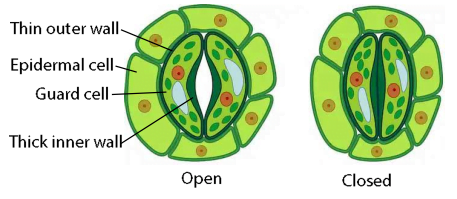
Difference between Guard cells and epidermal cell
| Guard cells | Epidermal cells |
| Has chloroplast | Lacks chloroplast |
| Prominent nucleus | Less prominent mixture |
| Kidney shaped | Irregularly shaped |
| Uneven thick walls | Uniform cell wall |
| Dense cytoplasm | Less dense cytoplasm |
The opening and closing
Stomata opening and closure depends on changes in turgor of the guard cells if water flows into the guard cells by osmosis, their turgor increases and they expand. But they do not expand uniformly in all directions. The relatively inelastic inner wall makes them bend and draw away and the pore opens. If the guard cells lose water the reverse happens: their turgor decrease and they straighten, thus the pore closes.
Mechanism of opening and closure of the stomata
- Sugar hypothesis
Guard cells contain chloroplast; these photosynthesize when exposed to light. Accumulation of sugar in the guard cell lead to osmotic uptake of water. When the guard cells become turgid, the thinner cell wall stretch while the thicker wall resist expansion and draw from each other creating a pore.
Limitation of this mechanism
- The stomata response is too rapid to be explained accumulation of sugars in the guard cells.
- Some stomata open at night and close during the day
- Some guard cells lack plasmodesmata
- Enzymatic conversion of starch to glucose
At high pH or low carbon dioxide concentration, enzymes convert starch to sugars. This lead to osmotic uptake of water and opening of stomata in light or during day. At night, there is no photosynthesis, carbon dioxide accumulates, and the pH falls, enzyme convert sugar or glucose to starch. This lowers the osmotic potential of the guard cell, and lose water by osmosis which leads to closure of the stomata.
Limitation of enzymatic hypothesis theory
- Some guard cells contain no starch
- Some guard cells do not contain chloroplast
- Some stomata open during the night and close during the day.
- Active uptake of ions
This hypothesis suggest that stomata open due to active uptake of potassium ions. This increase the osmotic potential of the guard cells leading to osmotic uptake of water and opening of the stomata.
Alternatively, loss of potassium ions by diffusion lower osmotic potential of the cell, loss of water by osmosis and closure of the stomata.
Adaptations of the guard cells to their functions
(i) they are kidney – shaped to enable them form a pore between them when they become turgid.
(ii) Have chloroplast which carries out photosynthesis thus forming sugar.
(iii) Have large vacuoles which regulate the osmotic pressure of the cell.
(iv) Thicker inner walls & thin outer walls; enables them to bulge outwards when turgid.
Transport of organic substances
These are transported /translocated in the phloem.
Evidences for transportation of organic materials in the phloem
- When phloem is cut, the sap exudes is rich in organic material such as carbohydrate. The fact that sap is exuded suggests that the content of the poem is under pressure.
- The sugar content of the phloem varies with environment conditions i.e., where condition favor photosynthesis, the concentration of sugar in phloem increases indicating that phloem transport photosynthetic products.
- Removal of a complete ring of phloem from around a stem causes an accumulation of sugars above the ring, indicating that their down progress has been interrupted.
- If radioactive 14CO2 is given to the plants as photosynthetic substrate, the sugar later found in phloem contain 14C. when phloem and xylem are separated by waxed paper, the 14C is almost entirely found in the phloem.
- Aphids need-like mouthparts with which they penetrate phloem in order to obtain sugars. Fluids obtained from cut mouth of anaesthetized aphid are analyzed to contain sugars.
Mechanism of translocation
- Mass flow: this is a process where particles move in the same direction at the same speed.
The mass flow is believed to occur in the sieve tubes may be illustrated by the Munch model below:

When set up correctly, water enter through the left-hand funnel by osmosis creating hydrostatic pressure that pushes water out of the right hand until the concentration of solute on either side is equal.
Continuous flow in the phloem is caused by continuous loading of sugars by active transport in the leaves and their continuous removal in the root.
Strength of mass flow theorem
(i) Sucrose concentration is higher at the source than at sink
(ii) sap oozes out suggesting it is under pressure
(iii) viruses are only transported from source to sink.
Weaken of mass flow theorem
(i) Solute move around in different direction
(ii) Different solutes move at different rates.
Halophytes
These are plants that survive in saline water e.g. mangrove.
Adaptations of halophytes to their habitat
– Possess succulent leaves and/or stem for storage of water
– Have salt glands to secrete excess salts
– Have thick cuticle to reduce water loss
– Have sunken stomata to reduce transpiration.
– Some have aerial roots for gaseous exchange
– Some have organic solutes like sorbitol for gaseous exchange.
– Some exhibit vivipary i.e. seeds germinate while still attached to the parent plant and grow into self-sustaining seedling before they fall off.
Dawn load the links below to get sample questions and answers on this topic
Transport on flowering plants & transpiration (A-level)
Please find free downloadable notes, exams and marking guides of agriculture, biology, Physics, chemistry etc. from digitalteachers.co.ug website.
Dr. Bbosa Science


Thanks so much .may God continually bless you
Good notes
I’ve been absent for a while, but now I remember why I used to love this web site. Thank you, I’ll try and check back more often. How frequently you update your web site?
Your writing style is truly engaging. Stationary
I’m looking forward to your next piece! 500 ka redeem code
Simplify your admission process with MBBS Direct Admission in Uttar Pradesh, ensuring a seamless experience.
Learn about cost-effective learning opportunities at MBBS Fees Structure in Orissa.
Start playing with added advantages using the Raja Luck Invite Code.
Invite buddies and make recommendation rewards utilizing the Diu Win Invite Code.
Enjoy devoted support and the current innovation with Server Rental in Noida.
Get the best online gaming experience with interactive features on bdg win.
Find exciting challenges and real-time gaming on 55 club.
I was impressed by how fast OnlyMP3 converts videos to MP3 without any loss in quality.
Thanks for the shopping recommendations! I explored markets with a friendly guide from Escort Service In Nainital who knew all the very best locations.
Absolutely nothing beats the warmth of Homemade Taste in every bite.
Track record matters when it pertains to a Chennai Escorts Service.
Keep in mind to prioritize safety when looking for a Call Girl In Dehradun.
Follow all the action from the **IPL**, consisting of match updates, team news, and crucial performances.
So glad I found https://www.youtube.com/@kpopbuzzindo/shorts – it’s perfect for quick doses of K-pop joy!